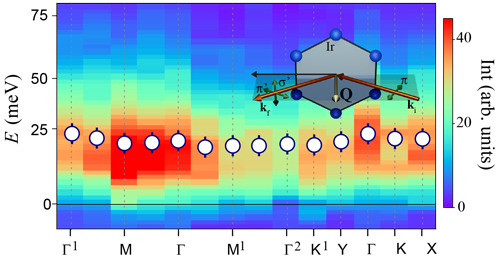
Quantum spin liquids (QSLs) are an exotic and elusive phase of matter with unusual magnetic properties that offer tantalizing prospects for quantum computing applications. But before such prospects can be realized, physicists need to understand much more about the QSL state, including how to precisely define and distinguish a true QSL from other phases of matter.
Using X-ray spectroscopy, a group of researchers from Brown University, Boston College, and the U.S. Department of Energy’s (DOE) Argonne National Laboratory studied a material that's considered a strong candidate for a state called a Kitaev quantum spin liquid (KQSL), but instead discovered a new state of matter that appears to be a previously unknown type of QSL. Their work appeared in Nature Communications.
The term "quantum spin liquid" has little to do with the common notion of a liquid such as water or coffee, but instead refers to the simultaneous presence of energetically equivalent electron spin configurations that combine into a single, superposed entangled quantum state. The chaotic, ever-fluctuating lack of alignment of electron spins, even as temperature approaches near absolute zero, resembles the everyday liquid in that it lacks a periodic, fixed arrangement of atoms characteristic of crystalline solids. This extreme disorder results from what's called a frustrated magnetic state, which can take various forms, making QSLs even harder to pin down. One such state is the Kitaev spin liquid, in which electron spins interact in a layered honeycomb structure. The team set out to map the magnetic excitations and characterize the magnetic state of the compound H3LiIr2O6 through high-resolution resonant inelastic X-ray scattering (RIXS) measurements at the 27-ID beamline of the Advanced Photon Source, a DOE Office of Science user facility at Argonne.
Previous work had shown that this compound contains some characteristics that would seem to disqualify it from being a pure Kitaev QSL, including faults in the stacking of honeycomb layers, and hydrogen zero-point motion (hydrogen atom vibrations at near absolute zero temperature due to confinement at atomic scales). Such observations made it clear that something unusual was going on with this compound, but the exact nature of its spin and magnetic state remained elusive. The investigators used RIXS to probe these phenomena more closely.
They found a broad excitation spectrum with a high-energy tail forming a continuum of magnetic excitations, which can be described as an overdamped harmonic oscillator. The overdamped excitations showed a lack of momentum dependence, indicating that the compound is not quite a true Kitaev quantum spin liquid state since the anisotropic spin interactions inherent to the KQSL state would result in anisotropic momentum dependence. The researchers noted that the observed stacking faults and bond disorder may prevent the formation of a KQSL in this compound.
A lack of momentum dependence leads the investigators to conclude that H3LiIr2O6 represents a disordered topological spin liquid -- not quite meeting the complete definition of a pure Kitaev quantum spin liquid, but instead something similar, constituting in effect a new type of QSL.
As intensive efforts continue to achieve a better understanding of the curious state of matter called a quantum spin liquid, this work demonstrates that such materials can exist in even more varied forms than previously theorized. That insight and further research will help to accelerate the realization of possible practical applications for quantum spin liquid materials. – Mark Wolverton
_________________________________________________________________________________
See: A. de la Torre1, B. Zager1, F. Bahrami2, M. H. Upton3, J. Kim3, G. Fabbris3, G.-H. Lee4, W. Yang4, D. Haskel3, F. Tafti2, K. W. Plumb1, “Momentum-independent magnetic excitation continuum in the honeycomb-iridate H3LiIr2O6” Nat Commun 14 5018 (2023)
Author affiliations: 1Brown University; 2Boston College; 3Argonne National Laboratory; 4Lawrence Berkeley National Laboratory
We thank J. Knolle and P. A. Lee for useful discussions. Work performed at Brown University by A.d.l.T., B.Z., and K.P. was supported by the U.S. Department of Energy, Office of Science, Office of Basic Energy Sciences, under Award Number DE-SC0021265. Work carried out at Boston College by F.B. and F.T. was supported by the National Science Foundation under award number DMR-2203512. This research used resources of the Advanced Photon Source, a U.S. Department of Energy (DOE) Office of Science User Facility operated for the DOE Office of Science by Argonne National Laboratory under Contract No. DE-AC02-06CH11357. This research used resources of the Advanced Light Source, which is a DOE Office of Science User Facility under contract no. DE-AC02-05CH11231.
The U.S. Department of Energy's APS at Argonne National Laboratory is one of the world’s most productive X-ray light source facilities. Each year, the APS provides high-brightness X-ray beams to a diverse community of more than 5,000 researchers in materials science, chemistry, condensed matter physics, the life and environmental sciences, and applied research. Researchers using the APS produce over 2,000 publications each year detailing impactful discoveries and solve more vital biological protein structures than users of any other X-ray light source research facility. APS X-rays are ideally suited for explorations of materials and biological structures; elemental distribution; chemical, magnetic, electronic states; and a wide range of technologically important engineering systems from batteries to fuel injector sprays, all of which are the foundations of our nation’s economic, technological, and physical well-being.
Argonne National Laboratory seeks solutions to pressing national problems in science and technology. The nation's first national laboratory, Argonne conducts leading-edge basic and applied scientific research in virtually every scientific discipline. Argonne researchers work closely with researchers from hundreds of companies, universities, and federal, state and municipal agencies to help them solve their specific problems, advance America's scientific leadership and prepare the nation for a better future. With employees from more than 60 nations, Argonne is managed by UChicago Argonne, LLC, for the U.S. DOE Office of Science.
The U.S. Department of Energy's Office of Science is the single largest supporter of basic research in the physical sciences in the United States and is working to address some of the most pressing challenges of our time. For more information, visit the Office of Science website.
